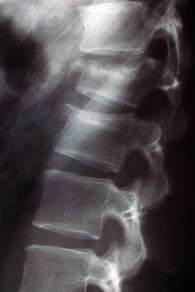
|
|
Strong Bones:

Osteoporosis is a disease in which bones lose substance and strength; they become fragile and are therefore more likely to break. Typically these "fragility" fractures occur in the spine, hip, and wrist. Those in the hip are most concerning and almost always require hospitalization. Some patients never recover. Compression fractures of the spine can cause loss of height and deformity (a "hunched" back).
Often bone loss is occurring unnoticeably-- without symptoms, until a break, or fracture occurs, at which point it is suddenly painful, and often debilitating. But bone loss can be identified before it becomes symptomatic through bone densitometry-- an easy, accurate, painless, and non-invasive radiologic examination covered by most insurances. The perimenopausal years, when the natural bone strengthener, estrogen, begins to dwindle, is a time when bone loss begins to become a concern. Bone densitometry at this time can identify one's baseline bone health and provide a basis for an ongoing bone health maintenance plan. Women can lose up to 20% of their bone mass in the 5-7 years following menopause.
Adequate calcium and vitamin D are vital to maintaining strong bones and avoiding the consequences of osteoporosis. Daily supplements as well as a diet fortified with calcium and vitamin D rich foods are recommended for all women beginning in adolescence. (Women acquire 98% of their bone mass by age 20!) Weight bearing and resistance training exercises are also necessary, again beginning in adolescence. Smoking and excessive alcohol intake should be avoided. Consider a baseline bone density examination to identify your current bone health and determine a lifelong bone maintenance program!
Often bone loss is occurring unnoticeably-- without symptoms, until a break, or fracture occurs, at which point it is suddenly painful, and often debilitating. But bone loss can be identified before it becomes symptomatic through bone densitometry-- an easy, accurate, painless, and non-invasive radiologic examination covered by most insurances. The perimenopausal years, when the natural bone strengthener, estrogen, begins to dwindle, is a time when bone loss begins to become a concern. Bone densitometry at this time can identify one's baseline bone health and provide a basis for an ongoing bone health maintenance plan. Women can lose up to 20% of their bone mass in the 5-7 years following menopause.
Adequate calcium and vitamin D are vital to maintaining strong bones and avoiding the consequences of osteoporosis. Daily supplements as well as a diet fortified with calcium and vitamin D rich foods are recommended for all women beginning in adolescence. (Women acquire 98% of their bone mass by age 20!) Weight bearing and resistance training exercises are also necessary, again beginning in adolescence. Smoking and excessive alcohol intake should be avoided. Consider a baseline bone density examination to identify your current bone health and determine a lifelong bone maintenance program!